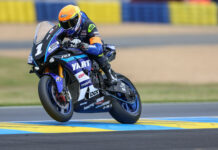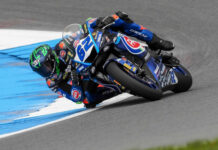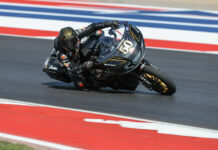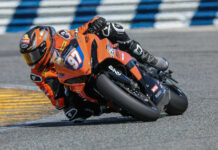From a press release issued by AMA Pro Racing:
Reflecting the changing motorcycle marketplace, needs of the manufacturers, benefit to racers and, most importantly, the interests of fans, AMA Pro Racing has revised its class structure for the AMA U.S. Superbike Championship. The new class structure will be implemented beginning with the next racing season.
“The task of developing an all-new class structure is an extraordinarily complex process and it is impossible to satisfy everyone,” said Scott Hollingsworth, CEO of AMA Pro Racing. “Our primary objectives are to deliver the best possible show to our fans while focusing on the market development of professional motorcycle racing in the United States.”
The new classes include Superbike, Supersport, Formula Xtreme and Superstock and are outlined as follows:
Superbike:
Supersport:
Formula Xtreme:
Superstock:
This class structure has been approved by the AMA Pro Racing Board of Directors for 2004 season implementation. Technical rules within this class structure are subject to a 30-day public comment period upon publication and all AMA Pro Racing credential holders are invited to submit comments for consideration. New technical rules are expected to be issued in early May.
Merrill Vanderslice, AMA Pro Racing Director of Competition states the new classes represent a logical and equitable evolution of the current structure. “Each class was scrutinized to see that it makes sense to the racing community. We adjusted the Superbike class so it remains the premier class in our championship but also took a close look at each of the support classes. For example, we must objectively recognize the current state of two-stroke development but at the same time remain mindful of the needs of the small but loyal group that enthusiastically follows that particular class of racing.”
Hollingsworth added, “Larger grids, expanded media opportunities and increased business opportunities will be the result of our new class structure. Additionally, we recognize that the structure set forth by AMA Pro Racing ends up being the world standard and we take that responsibility very seriously. AMA Pro Racing is the leading national sanctioning body for professional motorcycle sport in the world and our initiatives have impact around the globe. This new structure represents a good combination of classes that will set the stage for an entertaining, highly promotable show.”
Frequently Asked Questions
Why are you eliminating 750s from the Superbike class?
The vision for the Superbike class is that it should represent the pinnacle of production-based competition motorcycles in terms of technical advancement. Currently, big-bore sport bikes (900cc-1000cc) reflect that ideal. Each participating manufacturer either produces (or will soon produce) a flagship model that fits into this class.
Modern 1000cc Superbikes are very fast. Have these machines become too fast?
While we’re allowing increased displacement for multis, we’re limiting the number of engine modifications in the interest of controlling speeds. Additionally, rider safety continues to be at the forefront of AMA Pro Racing’s objectives. To meet the challenge posed by ever-faster race bikes, we have taken many steps to enhance safety. This includes track changes at a number of locations, increased use of safety materials such as air modules, and the elimination of tracks that no longer meet our requirements for safety. We will continue to aggressively explore means to protect our riders.
The Supersport class appears to be relatively unchanged. Why?
The Supersport class continues to offer the closest racing with a large number of participants. It’s also a relatively inexpensive class and thus attracts a greater pool of riders and teams. Finally, middleweight sport bikes represent a tremendously large sales category for the manufacturers and fans enjoy seeing AMA Pro Racing riders competing on essentially the same machines anyone can buy. There was no reason to change this highly popular class.
Formula Xtreme seems to have changed the most dramatically. Please explain the thinking that went into the changes in this class.
With Superbike being based on 900cc-1000cc motorcycles there began to be too much similarity between it and Formula Xtreme. Additionally, the original vision of Formula Xtreme was to offer a class that encouraged the greatest amount of “creativity” among race bike builders and tuners. With broad equipment parameters and rules that allow for extensive modifications, this class will produce some very interesting machinery and provide a home for a large number of racers. The result will be highly entertaining racing and plenty of room for fan debate.
Considering its grid is made up largely of one brand, is there still a need for the Superstock class?
Absolutely. Until 2003, the Superbike class was primarily based on 750cc motorcycles and for the past two decades, 750s represented the best of sport bike design. With the emergence of lightweight, big-bore sport bikes that has changed, however there is still a devoted following of 750s. By keeping this class and expanding it to include multi-cylinder machines up to 1000cc (and continuing to include twins up to 1350cc) we will see increased participation among more riders and brands. This class allows minimal modifications and is the place for racers to establish themselves as they move toward the premier Superbike class.
Why has the 250 Grand Prix class been eliminated?
250 GP equipment has been incorporated into the new Formula Xtreme class which will allow aficionados of 250 racing to continue racing and, in fact, develop their bikes even further. We’ve created the opportunity for these bikes to continue competing at the national level.
Who makes the decisions regarding class structure and technical rules?
AMA Pro Racing personnel are the primary decision makers. For class structure, market conditions, product availability, racer input and the goal of positive growth and development of professional motorcycle racing represent some of the criteria that is considered. Road Racing Advisory Board recommendations are also taken into account. Class structure recommendations are subject to approval by the AMA Pro Racing Board of Directors. Technical rules are developed by AMA Pro Racing personnel, subject to a 30-day public comment period and approval by the AMA Pro Racing Board of Directors. This multi-level check and balance system helps to ensure a positive outcome of the process.
How long will this new class structure be in effect?
The horizon for this class structure is three to five years unless market conditions or technological development makes it obsolete in which case it may be adjusted or changed.
About AMA Pro Racing
AMA Pro Racing is the leading sanctioning body for motorcycle sport in the United States. Its properties include the AMA Supercross Championship, the AMA Chevy Trucks U.S. Motocross Championship, the AMA Chevy Trucks U.S. Superbike Championship, AMA Progressive Insurance U.S. Flat Track Championship and the AMA Red Bull Supermoto Championship. Nearly 2 million race fans attended AMA Pro Racing events during the 2002 season. For more information about AMA Pro Racing, visit www.amaproracing.com.






